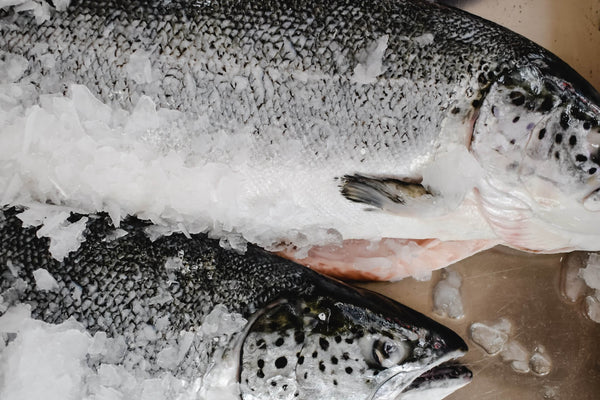Yes, There are Different Types of Salmon - Here's a Quick Guide
Updated on Jun 12, 2023
If you’ve ever stood in front of the seafood counter wondering what sets one salmon fillet apart from another, you’re not alone. Salmon isn’t just salmon — there are several distinct species, each with its own flavor, texture, and best use in the kitchen. Whether you’re preparing sushi, grilling for a crowd, or just looking for the healthiest pick, understanding your options can help you make a better choice at checkout.
Let’s start with one of the biggest distinctions: wild vs. farmed salmon.
Farmed vs. Wild-Caught Salmon
Before we dive into specific types of salmon, it’s important to know how your salmon was raised. This single detail can tell you a lot about flavor, texture, price — and even sustainability.
Wild-caught salmon grow in natural habitats like the Pacific Ocean, rivers, and lakes. Because they swim long distances and eat a natural diet, their meat is leaner, firmer, and packed with flavor. They're also rich in Omega-3s and often considered the more nutritious option. Common wild species include Sockeye, Chinook, Coho, Pink, and Chum.
Farmed salmon, on the other hand, are raised in ocean pens or tanks. The most common farmed variety is Atlantic salmon, which is no longer widely available in the wild due to overfishing. Farmed salmon has a softer texture and milder taste, thanks to a controlled diet and less active lifestyle. It’s typically available year-round and often comes at a lower price point.
Both types have their place. If you’re after bold flavor and nutritional punch, wild might be the way to go. If you want something budget-friendly and consistent, farmed salmon can work just as well — especially for everyday meals.
Related: Wild Caught vs. Farm Raised Salmon: What’s the Difference?
5 Different Types of Salmon Found in North American Waters
North America is home to five main species of Pacific salmon, all of which are typically wild-caught and thrive in the cold waters of the Pacific Ocean and surrounding rivers. Each type has its own distinct taste, texture, and ideal use in the kitchen.
1. Chinook Salmon

Known as the “King” for good reason, Chinook salmon is the largest and richest-tasting of the Pacific species. It has a high fat content, giving it a buttery, melt-in-your-mouth texture that makes it ideal for grilling or enjoying raw as sashimi.
Flavor: Rich, buttery, luxurious
Texture: Tender and moist
Best for: Grilling, broiling, slow-roasting, sushi/sashimi
Season: Late spring to early fall (peak: May–July)
Other names: King Salmon
Scientific name: Oncorhynchus tshawytscha
If you’re looking to splurge or impress guests, Chinook is the premium choice.
2. Coho Salmon

Coho salmon is a popular pick for home cooks who want a balance of flavor, firmness, and versatility. It’s milder than Chinook but still rich enough to hold up well in a range of recipes. Coho also tends to be more affordable and easier to find during its peak season.
Flavor: Mild yet flavorful
Texture: Firm and meaty
Best for: Baking, pan-searing, smoking, salads, tacos
Season: Mid-summer to early fall (peak: August–September)
Other names: Silver Salmon
Scientific name: Oncorhynchus kisutch
If you want something that’s flavorful but not too bold, Coho is a reliable and tasty middle ground.
3. Chum Salmon

Chum salmon doesn’t get as much attention as the flashier species, but it plays a vital role in both commercial fisheries and traditional diets. It’s lower in fat and has a lighter flavor, making it a practical choice for recipes that rely on smoking or seasoning. While it’s less common in fresh form, you’ll often find it canned or frozen.
Flavor: Mild and light
Texture: Lean and soft
Best for: Smoking, canning, fish cakes, patties, salmon spreads
Season: Late summer to early winter (peak: September–October)
Other names: Keta Salmon, Dog Salmon, Silverbrite
Scientific name: Oncorhynchus keta
If you’re looking for an economical option for smoking or prepping in bulk, Chum is worth a try.
4. Sockeye Salmon

Sockeye salmon is a favorite among salmon lovers for its bold flavor and vibrant color. With deep red flesh and a firmer, leaner texture, it holds up beautifully to grilling, roasting, or pan-searing. It’s also one of the most sought-after choices for high-quality canned salmon.
Flavor: Bold, rich, and distinctly “salmony”
Texture: Lean and firm
Best for: Grilling, pan-searing, roasting, canning, smoking
Season: June to early August (peak: July)
Other names: Red Salmon
Scientific name: Oncorhynchus nerka
If you want that classic wild salmon taste, Sockeye delivers every time—especially in summer.
5. Pink Salmon

Pink salmon is the smallest and most abundant of the Pacific species. Its mild flavor and soft texture make it ideal for canning or simple recipes like salmon cakes or salads. Because it’s widely available and lower in fat, Pink salmon is a great budget-friendly option for everyday meals.
Flavor: Very mild
Texture: Soft and delicate
Best for: Canning, poaching, baking with sauces, salmon patties, salads
Season: Odd-numbered years, mostly July–August (especially in Alaska)
Other names: Humpback Salmon
Scientific name: Oncorhynchus gorbuscha
Looking for an affordable wild-caught salmon? Pink salmon is often the most accessible way to enjoy it.
Summary
Salmon isn’t one-size-fits-all. From rich and luxurious Chinook to practical, everyday Pink, each type brings something different to the table. If you’re grilling for a special occasion, Sockeye or King might be your best bet. Want something affordable for salmon patties or salad? Go with Pink or Chum. And if you’re somewhere in the middle, Coho is a solid choice.
At Alaskan Salmon Company, we make it easy to explore them all. Our wild-caught sockeye salmon is flash-frozen at peak freshness and shipped straight to your door—so you can enjoy premium quality no matter where you are.








